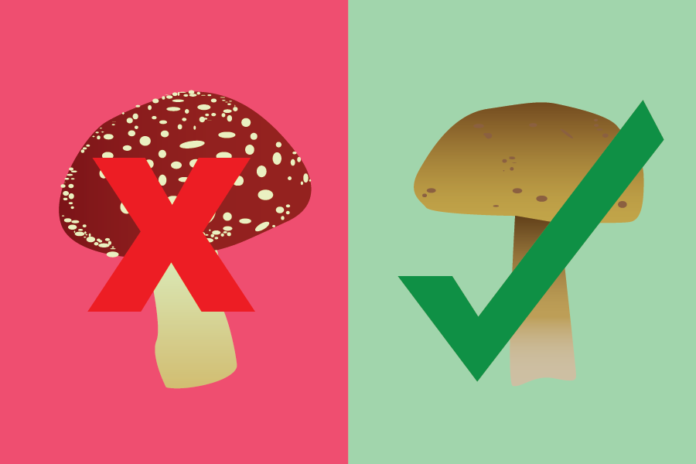New diagnostic test screens for mushroom poisonings in humans, animals
Researchers from UC Davis and the United States Department of Agriculture (USDA) have developed a portable field test for detecting the presence of the toxin amanitin found in poisonous mushrooms. Eating poisonous mushrooms causes over 100 deaths per year in humans and many more in animals. This quick screening test can help doctors and veterinarians alike determine if their patients are suffering from the effects of consuming toxic mushrooms.
“For the longest time we figured dogs can be exposed to these mushrooms, but we didn’t have an assay to confirm exposure,” said Robert Poppenga, a professor of veterinary toxicology in the school of veterinary medicine.
This new diagnostic test changes that. Dr. Candace Bever, a UC Davis graduate now working at the USDA, developed an antibody based quick-screen to test for the presence of amanitin in a urine sample. While her test looks like a pool pH strip in a little plastic rectangle, it is far from simple.
“It’s based on an antibody,” said Mike Filigenzi, an analytical chemist in the California Animal Health and Food Safety Laboratory. “An antibody is a molecule that grabs onto another molecule very specifically, like a lock and a key. In this case, her test is based on the ability of the antibody to grab onto the amanitin. She can use that to show whether it is in the mushroom or not.”
To use the test, researchers place a drop of liquid — usually a urine or tissue sample — onto the paper strip. The liquid wicks upward and reacts with antibodies embedded in the paper. If both lines are visible, the result is negative, but if one line disappears, that means the sample tests positive for aminitin. The result is easy to read and could even be used by amateur mushroom collectors as a field test.
UC Davis researchers confirmed the accuracy of the quick test using the old-fashioned in-lab method, Filigenzi explained.
“Our type of testing is considered a gold standard,” Filigenzi said. “It uses complex, expensive instruments and it takes time. [Bever’s] test is a few bucks and it’s very quick.”
This quick screening test has several advantages for both veterinarians and primary care doctors. It’s fast, accurate and cheap. While it is not yet available to the public, there are plans to commercialize the test and make it widely available for hospitals, vet clinics and, potentially, amateur mushroom foragers. In hospitals, the test could expedite treatment for serious cases of poisoning.
“The first sign of poisoning is vomiting and diarrhea,” Poppenga said. “After that, the patient seems to recover, but then they get sick from the liver damage. The physician can test urine for the toxin very quickly to rule in or out exposure without having to ship it to a lab like ours for testing.”
People tend to brush off these symptoms as food poisoning, but even after they subside, the toxin filters through the liver and can cause even greater damage and death. In serious cases, the only treatment is a liver transplant.
“Medical personnel may not be able to identify a mushroom by sight,” said Mike Davis, a retired professor of plant pathology and author of Field Guide to Mushrooms of Western North America. “A test makes it possible for a non-mycologist to rule out mushrooms with that toxin.”
If a dog shows signs of liver problems that are characteristic of amanitin poisoning, veterinarians can now use this test to get a positive or negative result in minutes.
“We collaborate with an emergency veterinary clinic in Marin County,” Poppenga said. “When they have a suspicious case, they send us the samples. Typically, we can get results back to them in about half a day. The nice thing about that is that the pet owner can decide whether to pursue treatment quickly.”
If the test becomes commercially available, the time to diagnosis may decrease even more drastically as vets can perform these screenings on-site without a full lab test.
In addition to its medical applications, the test could also be of interest to amateur mushroom foragers. With the right experience, the mushroom collector could test fungi for aminitin in the field. A negative result, however, does not mean the mushroom is edible. This test in particular checks for the presence of the chemical compound aminitin, so a mushroom may still contain other toxins that cannot be detected.
The rule of thumb with mushrooms in the wild is to not eat them at all. While this seems straightforward, there are still many cases of poisoning every year in humans.
“One of the issues is that, in Southeast Asia, there is a type of mushroom that is edible and very delicious that looks very much like one of the toxic mushrooms here,” Filigenzi said. “People who immigrate over from areas where those mushrooms are common will collect toxic mushrooms not knowing what they’re getting is deadly. There have been a number of poisonings based on this scenario.”
So, while that death cap mushroom may look appetizing, think twice before touching it.
“These are pretty nasty mushrooms,” Filigenzi said. “Don’t eat them.”
Written by: Lauren Glevanik — science@theaggie.org




